Choosing the right motorcycle engine is like finding the perfect key to open your riding adventure. As a new rider, you'll want to understand the essential specs that can make or break your experience on the road. Factors like engine displacement, power output, and torque play significant roles in how your bike handles and performs. But what do these terms really mean for you, and how can they impact your confidence and safety? Let's explore these critical elements to guarantee you're well-equipped for your journey ahead.
Key Takeaways
- Engine Displacement: Choose bikes with 250cc-500cc for manageable power suitable for beginners, enhancing control and comfort.
- Engine Type: Opt for four-stroke or parallel-twin engines for smooth power delivery and lower maintenance requirements.
- Torque Characteristics: Look for engines with immediate torque to aid in urban maneuvering and improve the overall riding experience.
- Cooling Systems: Consider liquid cooling systems for consistent temperature control, enhancing performance and fuel efficiency during rides.
Overview of Ducati Motorcycles
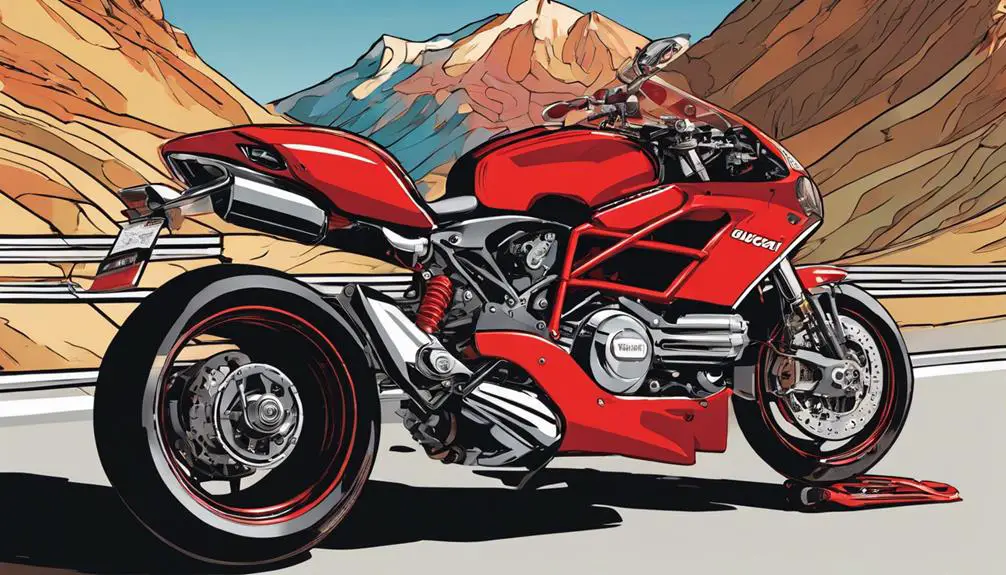
Ducati motorcycles are renowned for their striking design and powerful performance, making them a top choice for new riders seeking both style and speed. When you hop on a Ducati, you instantly feel the adrenaline rush that comes with riding a machine built for excitement. The sleek lines and bold colors don't just turn heads; they embody a spirit of freedom that many crave.
Each bike is crafted with precision, offering not only aesthetic appeal but also an engaging riding experience. You'll find that the ergonomics are designed to provide comfort while allowing you to connect with the road in a way that feels almost freeing. Whether you're maneuvering through city streets or carving through winding country roads, a Ducati gives you the confidence to push your limits.
Moreover, the community around Ducati is vibrant and welcoming. You'll discover fellow riders who share your passion for the open road, reinforcing that sense of belonging.
Key Engine Specifications
Understanding key engine specifications is vital for new riders looking to maximize their performance and enjoyment on the road. When you're on your bike, the engine is your lifeblood, and knowing its specs can lead to a more exhilarating experience.
Start with the engine displacement; this measurement in cubic centimeters (cc) tells you how much air and fuel can enter the combustion chamber. Generally, a higher displacement means more power, but it can also impact handling.
Next, consider the horsepower and torque ratings. Horsepower represents the engine's ability to do work over time, while torque indicates pulling power. For new riders, a good balance is imperative; you want enough power to feel liberated without overwhelming yourself.
Don't overlook the engine type; whether it's single-cylinder, parallel-twin, or V-twin, each offers a unique riding experience.
Engine Types for Beginners
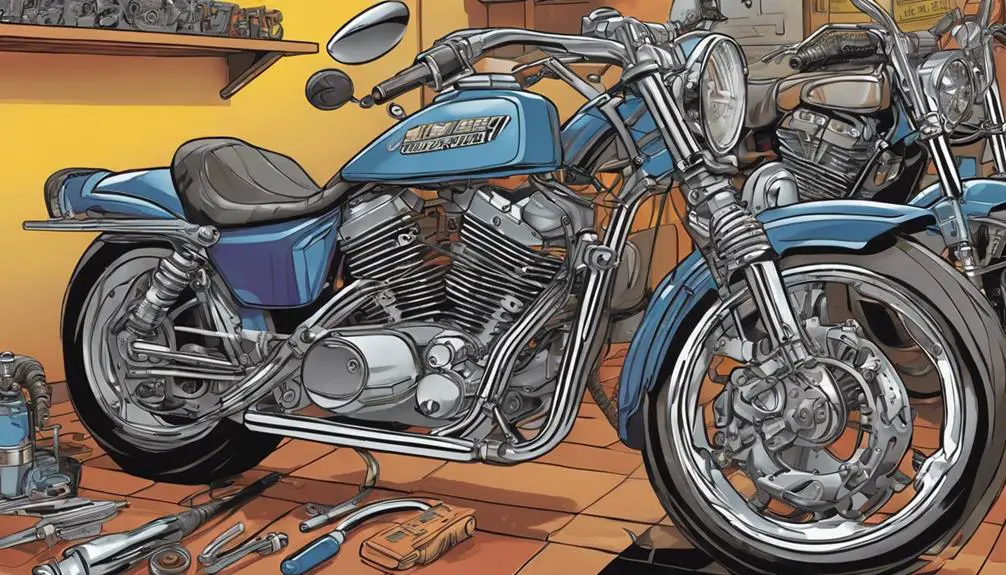
When you're starting out, understanding the differences between four-stroke and two-stroke engines is essential.
You'll also want to take into account engine displacement and how it affects power delivery.
These factors can greatly impact your riding experience, so let's break them down.
Four-Stroke Vs. Two-Stroke
Choosing between four-stroke and two-stroke engines can greatly impact your riding experience as a beginner.
Four-stroke engines are known for their smooth power delivery and fuel efficiency. They tend to require less maintenance and have a longer lifespan, making them ideal if you want to enjoy the ride without constant tinkering. You'll appreciate the quieter operation, too—perfect for those peaceful weekend trails.
On the other hand, two-stroke engines pack a punch with their lightweight design and snappy acceleration. They provide an exhilarating ride, allowing you to feel that rush of power the moment you twist the throttle. However, you'll need to be prepared for more frequent maintenance and a thirstier appetite for fuel. If you crave that raw, unfiltered experience and don't mind the extra work, a two-stroke might be your ticket to freedom.
Ultimately, your choice should reflect your riding style and maintenance comfort level. Whether you lean towards the reliability of a four-stroke or the excitement of a two-stroke, trust your instincts and choose the engine that will set you free on the open road.
Engine Displacement Importance
Engine displacement plays a crucial role in determining how a bike performs, affecting everything from acceleration to fuel efficiency. Fundamentally, it's the size of the engine, measured in cubic centimeters (cc). A larger displacement generally means more power, which translates to quicker acceleration and a more thrilling ride. If you crave that sense of liberation when you twist the throttle, understanding displacement can guide you in choosing the right bike.
For beginners, bikes with smaller displacements, typically between 250cc and 500cc, offer a sweet spot. They provide enough power for spirited rides while remaining manageable, allowing you to build confidence without feeling overwhelmed. On the other hand, larger engines can be exhilarating, but they require more skill to handle.
Consider what you want from your riding experience. If you're after smooth, easy cruising with great fuel efficiency, a modestly displaced engine might be your best bet. But if you seek the rush of speed and power, a bigger engine could be calling your name. Ultimately, knowing how engine displacement impacts performance helps you make informed choices that align with your desire for freedom on two wheels.
Power Delivery Characteristics
Different engine types deliver power in unique ways, impacting how the bike feels and responds under your control. If you're seeking a liberating ride, understanding these characteristics is essential.
Single-cylinder engines, for instance, offer raw, immediate torque. They give you a punchy feel that's perfect for maneuvering city streets.
On the flip side, parallel-twin engines smooth out the power delivery, making it more manageable and enjoyable for new riders. You'll find that these engines strike a balance—providing enough power while still being forgiving.
Then there are V-twin engines, which create a distinctive rumble. Their power delivery is rich and torquey, giving you a thrilling experience, especially at lower RPMs. If you crave cruising with a sense of freedom, this might be your best bet.
Lastly, inline-four engines are known for their high-revving nature. They deliver power smoothly but can feel overwhelming at lower speeds. If you're looking to release your inner speed demon on open roads, these engines might just be your ticket to exhilaration.
Choose wisely, and feel the liberation each engine type brings to your ride!
Power Output and Performance
Power output plays an essential role in determining how a motorcycle performs on the road, affecting everything from acceleration to handling. When you twist the throttle, you want to feel that surge of power propelling you forward, allowing you to merge into traffic, conquer steep hills, or enjoy those winding backroads. A higher power output typically means quicker acceleration, which can give you that exhilarating rush and freedom you crave.
However, it's not just about raw numbers; it's about how that power translates into real-world performance. You'll want to evaluate the bike's weight and power-to-weight ratio, as they directly impact agility and responsiveness. A lighter bike with robust power output can make you feel like you're flying, while a heavier machine might require more finesse to handle.
As a new rider, you should prioritize finding a balance between comfort and excitement. Choose a motorcycle that offers enough power to keep you engaged, but not so much that it feels overwhelming.
Embrace the journey and the freedom that riding brings, and let the power of your motorcycle enhance your experience on the open road.
Torque and Riding Experience
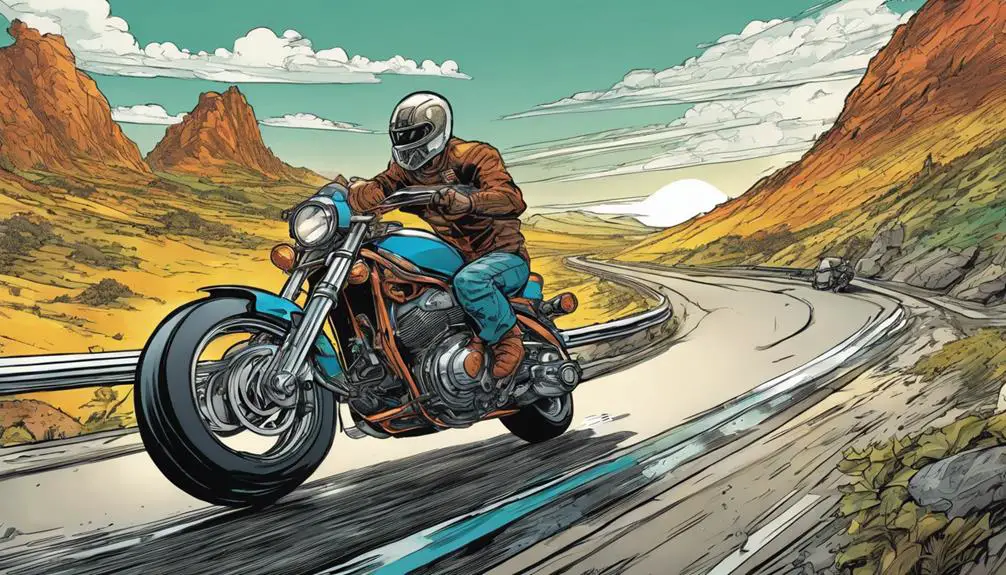
Torque plays an essential role in shaping your riding experience, influencing how quickly you can accelerate from a stop and how smoothly you can navigate through various terrains. When you twist the throttle, that surge of torque gives you immediate power, letting you feel the freedom of the open road. The right amount of torque can make your bike feel lively, responsive, and ready to conquer any challenge.
As a new rider, you'll appreciate how torque helps you tackle inclines and uneven surfaces with confidence. A bike with higher torque allows you to maintain control without feeling overwhelmed, enhancing your sense of liberation. You won't have to constantly shift gears, making your ride feel more seamless and enjoyable.
Imagine cruising down a winding road, effortlessly shifting your weight as your bike responds to your every command. That's the thrill of riding, and torque is at the heart of that exhilarating experience. It empowers you to explore new paths and embrace the journey ahead.
Engine Cooling Systems
When you're choosing a bike, understanding engine cooling systems is essential.
You'll find that air cooling and liquid cooling each have their own benefits, affecting performance and maintenance.
Let's break down these options and offer some handy maintenance tips to keep your ride running smoothly.
Air Cooling Basics
Air cooling systems rely on the flow of air to dissipate heat from the engine, ensuring ideal performance and longevity. As a new rider, you'll appreciate the simplicity and efficiency of this cooling method. In air-cooled engines, fins on the engine's surface increase the area exposed to the air. When you ride, the wind rushes over these fins, carrying away excess heat generated during operation.
One of the benefits of air cooling is its lightweight design. You won't find bulky radiators or complex plumbing systems here. Instead, you can enjoy a more streamlined and accessible engine layout. This simplicity also means fewer components that could fail, giving you peace of mind as you hit the open road.
However, remember that air cooling depends heavily on riding conditions. On hot days or in stop-and-go traffic, you may experience overheating. Keeping an eye on your engine temperature is essential. If you feel the heat rising, don't hesitate to pull over and let it cool down.
Understanding how your air cooling system operates empowers you to maintain your ride's performance and reliability, allowing you to experience the freedom of the road fully.
Liquid Cooling Advantages
While air cooling has its advantages, liquid cooling offers significant benefits that enhance engine performance and reliability.
When you ride, you want your machine to respond without hesitation, and liquid cooling helps achieve that. By circulating coolant through the engine, it maintains a consistent temperature, preventing overheating during those exhilarating rides.
This consistent temperature control allows your engine to perform at its best, providing better power output and fuel efficiency. You'll notice smoother acceleration and improved throttle response, giving you the freedom to enjoy every twist and turn of the road.
Liquid cooling systems are also more effective in high-performance scenarios, making them ideal for new riders who crave speed and agility. Plus, they tend to be quieter than air-cooled systems, so you can revel in the sound of the open road without unnecessary distractions.
Ultimately, choosing a bike with liquid cooling can enhance your riding experience, allowing you to release your spirit of adventure. It's about having the confidence that your engine will deliver when you need it most, freeing you to focus on the thrill of the ride.
Maintenance Tips Overview
Proper maintenance of your bike's cooling system is essential for ensuring its longevity and peak performance. Start by regularly checking the coolant level. If you notice it's low, top it off with the recommended mixture. Don't forget to inspect for leaks; a small puddle can lead to big problems.
Next, clean the radiator and hoses. Dust and debris can restrict airflow, causing overheating. A simple rinse with water can do wonders. While you're at it, examine the hoses for cracks or wear. Replace any damaged parts to keep the system in top shape.
Flush the cooling system as recommended in your owner's manual. This helps remove any buildup and keeps your bike running smoothly. Remember, using the right coolant is vital; avoid mixing different types, as this can cause chemical reactions that compromise performance.
Fuel Efficiency Considerations
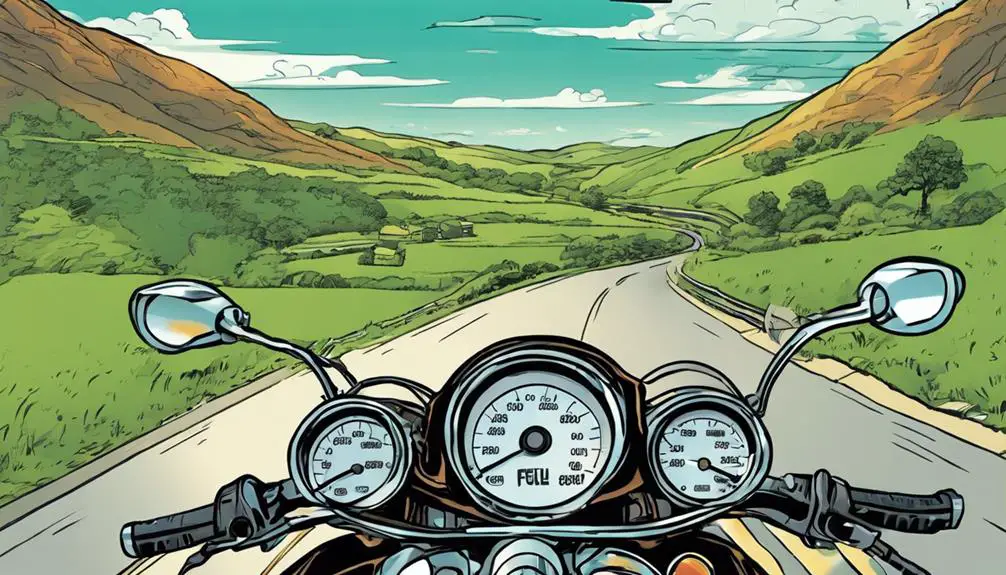
When choosing an engine, consider how fuel efficiency impacts your riding experience and overall costs. Fuel-efficient engines allow you to hit the open road more often without breaking the bank. You'll enjoy the freedom of longer rides and fewer stops at the pump, giving you more time to explore.
Here are some key benefits of opting for a fuel-efficient engine:
- Lower Fuel Costs: Save money on gas, allowing for more adventures.
- Extended Range: Travel further on a single tank, embracing the spirit of freedom.
- Reduced Emissions: Contribute to a cleaner environment and a better world for all.
- Less Frequent Fill-Ups: Spend more time riding and less time refueling.
Choosing an engine with good fuel efficiency isn't just a smart financial move; it enhances your riding experience. You'll feel liberated knowing you can roam freely without constantly worrying about fuel stops.
Common Engine Problems
Understanding common engine problems is essential for any new rider to guarantee a smooth and enjoyable experience on the road. You might encounter issues like overheating, which can stem from low coolant levels or a malfunctioning thermostat.
If your bike struggles to start, it could be a weak battery or fuel delivery issue. Pay attention to strange noises; knocking or grinding sounds often signal deeper mechanical problems that shouldn't be ignored.
Another common problem is oil leaks. If you notice dark spots under your bike, check for loose bolts or damaged gaskets. Ignoring these leaks can lead to engine damage down the line.
Also, be aware of excessive vibrations, which can indicate unbalanced wheels or worn-out components affecting your ride quality.
Maintenance Tips for New Riders
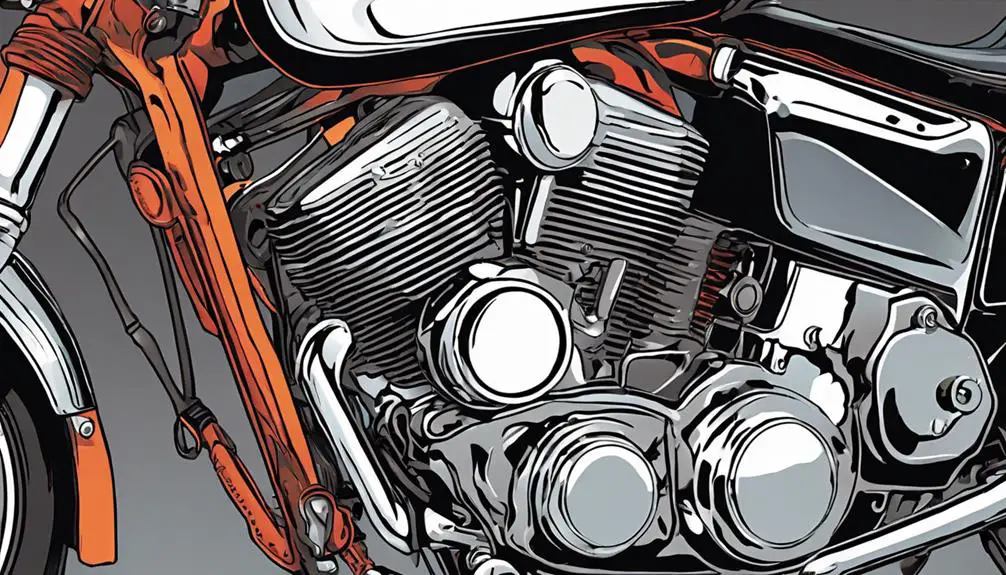
Regular maintenance is essential for keeping your bike running smoothly and ensuring your safety on the road. Embracing your freedom on two wheels means taking care of your ride. Here are some straightforward maintenance tips to help you out:
- Check the oil regularly: Engine oil lubricates and protects your engine. Change it according to your bike's manual.
- Inspect the tires: Look for wear and maintain proper pressure. Good tires are vital for grip and stability.
- Clean and lube the chain: A well-maintained chain improves performance and extends its life. Clean and lubricate it every few hundred miles.
- Test the brakes: Make sure your brakes are responsive. Replace pads if they're worn down. Safety first!
Frequently Asked Questions
What Is the Ideal Engine Size for Beginner Riders?
When you're considering the ideal engine size as a beginner rider, think about how much power feels comfortable for you.
Generally, engines between 250cc and 500cc offer a great balance of control and excitement.
You'll find these sizes manageable as you learn the ropes while still providing enough thrill to keep your spirit alive.
Are There Any Specific Engine Brands Recommended for New Riders?
When you're exploring engine brands as a new rider, look for those known for reliability and ease of use.
Brands like Honda, Yamaha, and Kawasaki often come highly recommended. They offer a range of beginner-friendly models that balance performance with manageable power.
You'll appreciate their solid construction and supportive dealer networks, which make maintenance easier.
Choosing the right brand can enhance your riding experience, letting you focus on the freedom of the open road.
How Important Is Engine Weight in Bike Performance?
When you think about engine weight in bike performance, consider a lightweight sport bike versus a heavier cruiser.
The lighter bike accelerates faster and handles better, giving you a thrilling ride.
Engine weight impacts balance and agility, so if you're looking for freedom on the road, a lighter engine can enhance your experience.
You'll feel the difference in maneuverability, making it easier to navigate twists and turns with confidence.
Can Engine Modifications Affect My Riding Experience?
Absolutely, engine modifications can greatly affect your riding experience.
When you tweak your engine, you might enhance power, improve throttle response, or even change the bike's sound, making your ride more exhilarating.
However, keep in mind that some modifications could impact reliability or handling.
It's crucial to choose changes that align with your riding style and goals so you can truly enjoy the freedom of the open road without any unnecessary complications.
What Safety Gear Should I Consider for New Riders?
When you hit the open road, you'll want to feel free, fearless, and fully protected.
For new riders, investing in a sturdy helmet, durable gloves, and a well-fitted jacket is essential.
Don't forget about reinforced pants and sturdy boots to shield against the elements and potential falls.
Each piece of gear empowers you, offering comfort and confidence while riding, so you can embrace the thrill of the journey ahead.
Safety should never take a backseat!
Conclusion
To sum up, understanding essential engine specs can truly enhance your riding journey.
Did you know that motorcycles with engine displacements between 250cc and 500cc make up nearly 60% of new riders' choices? This range offers the perfect balance of power and control for beginners.
By choosing the right engine type and paying attention to performance factors, you'll not only feel more confident but also enjoy every ride to the fullest.
Embrace the freedom that comes with being a new rider!